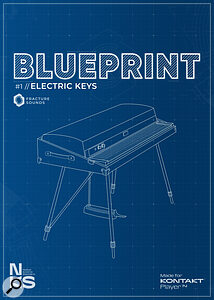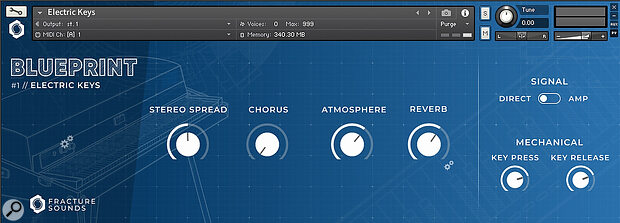Rating: ★ ★ ★ ★ 4/5 Stars
Fracture Sounds (FS from here on) recently announced their new ‘Blueprint’ imprint, described by the company as “an ever‑growing collection of free sample libraries for Kontakt Player”. This first instrument in the series is Electric Keys, based on a vintage Rhodes MkI Stage 73 Piano. Electric Keys generously incorporates several of the features found in their commercial libraries — a sort of ‘lite’ introduction to the FS sampleverse, if you will. Blueprint is downloaded and installed via Native Access, thus appearing in Kontakt’s Library tab — no hunting around in your file directory to find it is necessary. It also has full NKS support, so works with Komplete Kontrol hardware.
 The GUI design is in the established FS house style, clear and self‑explanatory — there’s absolutely no need for a manual, and indeed there isn’t one! All GUI controls can of course be controlled by MIDI via the usual MIDI Learn right‑click method. Delving under the hood in the full version of Kontakt, an examination of the key mapping and monitor tab reveal Electric Keys to employ (mostly) four velocity layers, with on average four round robins (one note appears to have as many as 11!), so this is clearly put together with some attention to detail.
The GUI design is in the established FS house style, clear and self‑explanatory — there’s absolutely no need for a manual, and indeed there isn’t one! All GUI controls can of course be controlled by MIDI via the usual MIDI Learn right‑click method. Delving under the hood in the full version of Kontakt, an examination of the key mapping and monitor tab reveal Electric Keys to employ (mostly) four velocity layers, with on average four round robins (one note appears to have as many as 11!), so this is clearly put together with some attention to detail.
The GUI offers four adjustable effects. Stereo Spread: not the usual artificial widening effect, but instead controlling the amount of stereo spread of keys from lowest on the left to highest on the right. Chorus: Kontakt’s newer Choral effect, a distinct improvement on the stock chorus of early versions. Atmosphere: a trademark of other FS instruments, this sustaining granular pad layer complements the main Rhodes sound with additional sustain and movement. Reverb: this is editable, with a choice of Hall or Room algorithms plus size, damping and modulation controls. Also included is a choice of Direct or Amp signals, the latter using Kontakt’s Twang amp effect fed through a Leslie cabinet impulse response, as opposed to a separate pool of ‘amped’ samples. Finally, the level of mechanical noises (key presses and key releases) can be individually adjusted to taste.
Tonally, this library tends toward the darker, mellower side — mainly due to its pre‑programmed EQ settings. Whilst the top‑most velocity layer (116‑127) has a pleasing bark, I did have to play reasonably hard to reach the top two layers; perhaps the second loudest layer should come in at a slightly lower velocity value than 101. Tonal consistency across the keyboard is good, with volume well balanced across the entire pitch range.
Owners of the full version of Kontakt will get the most mileage from Electric Keys, being able to delve under the hood to customise the instrument’s tone quite radically. Try tweaking the Twang amp settings, or swapping it and the cabinet for different models; in particular, experiment with your own settings of the EQ found in the Bus 1 insert strip. Blueprint runs in both the free and full versions of Kontakt 7 or higher; Electric Keys itself is a 2.21GB download.
Free
Free


